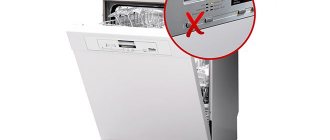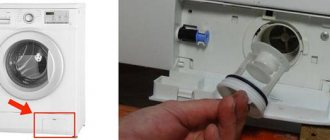Damage to the machine itself
This applies to equipment that has served you for many years. Possible damage inside the machine:
- the integrity of the insulation on the wires is broken;
- engine malfunction;
- Damage to the heating element or its switching relay.
Of all the listed reasons why a dishwasher periodically shocks, the most common is the last one. Damage to the heating element occurs due to poor quality of the supplied water. You can open the housing yourself and inspect the heating element for defects. If damage is still found, it will be necessary to replace the part with a new one.
Remember! Dishwasher repairs should only be carried out by a specialist.
Internal damage to the device
This problem most often appears in devices that have been serving in your kitchen for many years. Among such damages are:
- The insulation on the wires is broken;
- Engine problems;
- The heating element or its trigger mechanism was damaged.
It is the problems with the switching relay and the heating element itself that are the most common. The reason for the appearance of defects on heating elements is poor water quality. It’s very easy to check, just open the lid and inspect the heating element. If a malfunction is detected, it is worth replacing the part.
It is worth paying special attention to purchasing new parts. They must be branded, designed specifically for your device model. This guarantees a longer service life of the dishwasher and its serviceability after repair.
Inspection and replacement of the heating element of the dishwasher
The heater in the dishwasher is one of the most vulnerable elements. It suffers both from power surges and from low-quality water with a large number of impurities. In the latter case, potassium and magnesium salts settle on the surface and inside the heating element when heated and form a thick coating over time. In the worst case, the heater completely fails, and in the best, the dishwasher is electrocuted. The same thing happens with constant voltage surges - the normal operation of the heating element is disrupted.
To diagnose the heating element you must:
- disconnect the dishwasher from the power supply, do not just press the button, but unplug the cord from the outlet to completely eliminate the possibility of electric shock;
- shut off the water supply inside the device;
- disconnect all wires and hoses;
- remove the bottom panel of the dishwasher, remove the trays and water sprayers from its body;
- remove the drain filter;
- Unscrew the screws that usually hold the heating element at the bottom.
Most dishwashers are equipped with flow-through heating elements located under the bottom next to the pump.
For convenience, the switched off dishwasher can be placed on its side, having previously laid a soft towel.
After removing the heating element, you need to inspect it for damage. If the part looks completely functional from the outside, you can additionally use a multimeter and measure the resistance. The working heating element shows values within 21-22 Ohms; when diagnosing a faulty one, infinity appears on the display.
If the inspection shows that the heating element is in perfect order, then the dishwasher is electrocuted for other reasons. But if it is obvious that the problem is in the heater, then you need to buy and install exactly the same element.
Fault detection
The breakdown of the heating element can be determined using a saline solution and a multimeter. The heater is lowered into the solution, and the device measures the resistance. If there is resistance, then the heating element needs to be replaced with a new one.
Causes of the problem
First of all, it’s worth finding out why the dishwasher starts electrocuting in the first place? The causes of this problem can be divided into two main categories: violations when connecting the device to the network and problems with wiring, and the second is damage to the inside of the machine.
Internal damage to the device
This problem most often appears in devices that have been serving in your kitchen for many years. Among such damages are:
- The insulation on the wires is broken;
- Engine problems;
- The heating element or its trigger mechanism was damaged.
It is the problems with the switching relay and the heating element itself that are the most common. The reason for the appearance of defects on heating elements is poor water quality. It’s very easy to check, just open the lid and inspect the heating element. If a malfunction is detected, it is worth replacing the part.
It is worth paying special attention to purchasing new parts. They must be branded, designed specifically for your device model. This guarantees a longer service life of the dishwasher and its serviceability after repair.
How to check heating element
To check the heater, it must be removed. This is done as follows:
- Unplug the machine from the outlet;
- It is necessary to remove the sprinklers, dish basket and garbage filter from inside;
- If there are screws at the bottom of the tank (under the mesh), they must be unscrewed;
- Expand the device to open access to the bottom;
- Remove the bottom;
- Disconnect the heating element from the pipe;
- The removed heater must be inspected for damage and defects.
Fault detection
The breakdown of the heating element can be determined using a saline solution and a multimeter. The heater is lowered into the solution, and the device measures the resistance. If there is resistance, then the heating element needs to be replaced with a new one.
Second way
- Set the multimeter to resistance measurement mode (Ohm);
- We apply heating element to the contacts;
- If there is a problem, the device reading will be infinite, a working heating element shows 21-22 Ohms;.
- We again apply the probe to the contact, and the second to the grounded surface. Now the resistance should be infinite, that’s when the heating element is ok.
For this method, it is worth remembering that during measurement, the parts of the device must be dry (including the heating element). Otherwise, the results obtained cannot be considered accurate.
Wiring fault
The dishwasher may shock you due to faulty wiring. The leak may be due to the wiring, due to which the housing will be energized.
There are often situations when rodents make a nest directly in the housing and chew through the wiring. Then the problem appears. You can identify such a nest in a device using smell. Open the dishwasher and sniff, mice emit a specific smell, if there is one, you need to open the case.
If the problem is not rodents, the integrity of the wiring could still be compromised. There are many wires inside, one of which could be defective and simply burnt out. In addition, the insulation may have worn out over time. You need to carefully inspect all the wiring in the machine for their integrity. Pay special attention to the connections between the wiring and terminals and chips. Damaged wires need to be replaced.
If you have the skill to work with a multimeter, this device can speed up the test and significantly increase its efficiency. If no problems are found with the wiring, we proceed to inspecting the engine. It can also cause a leak.
What to do in this case? Using the same multimeter, we check the motor winding. If there is a leak in the housing, the engine will have to be replaced. Some people decide to have the motor rewinded, but this procedure is more expensive.
Incorrect network connection
One of the most common reasons why a dishwasher may be electrocuted is an incorrect electrical connection. Detailed instructions on how to do this are written in the instructions for the device. Dishwashers from different manufacturers have different connection conditions. This is due to differences in technical characteristics, so you should pay special attention to this issue.
But there is one basic rule that applies to all models of the device without exception: you can connect the dishwasher to the mains only through a Euro socket that has grounding.
If there are no European sockets in the house, it is worth installing one for the dishwasher. There is no need to resort to various tricks. Many people immediately change the Euro plug to a regular one, which is also a very big mistake and can lead to undesirable consequences, including a fire or breakdown of the device.
Instead of grounding, grounding can also be used: connection to a solid neutral. It is worth remembering that you should never do this yourself! This work should only be entrusted to a specialist. Otherwise, you can seriously damage the device, or, even more seriously, harm your own health!
Other Possible Causes
If the machine is electrocuted, this does not mean that it is the problem. If after checking the wiring and the inside of the device you do not find any problems, is it possible that the problem is in the socket? To eliminate this problem, the position of the outlet is very important (40-50 cm from the floor, next to the dishwasher itself). The socket contacts should also be checked; their oxidation could also be the cause. In addition, it is important to remember that the use of extension cords to connect such a powerful device is not allowed.
Causes of electric shocks
A washing machine is not the only appliance that can give users an electric shock. Refrigerators, electric kettles, dishwashers and other household appliances connected to the electrical network can become a source of danger. The device stings or receives an electric shock due to electrical leakage on the body. There are several reasons for this phenomenon:
- Wiring faulty. This is a real danger for users. A damaged cable, in contact with the housing, poses a threat whenever a person touches it. It is necessary to immediately inspect the internal wiring.
- Damp atmosphere. Equipment does not like dampness. And washing machines have to work directly with water. Most often they are installed in bathrooms, where it is quite humid. Water is an excellent conductor of electricity. If your hands are wet, then when you touch the body, you can feel a tingling sensation. This effect is not anomalous - it happens with almost all washing machines. Moreover, this happens more often with modern models. The claim here must be made that not all houses are equipped with grounding.
- If the engine or heating element breaks through. The breakdown goes to the body. The solution is to immediately replace the broken parts.
Don't forget about safety rules!
In order not to completely damage the device, and first of all, not to harm yourself, you should always remember the safety rules:
- Before looking for the cause of the breakdown or starting repairs, the device must be disconnected from the network;
- Do not touch the dishwasher with wet hands while it is plugged in;
- Do not install the device in a room with high humidity;
- If damage to the insulation is found on the wiring, socket or plug, it is better not to turn on the dishwasher.
Why is my dishwasher electrocuted?
When you touch the PMM body, do you feel a small discharge? Don't ignore the problems - they are very serious. With such symptoms, the causes of problems are divided into two types:
- Internal malfunctions of equipment, which causes breakdown.
- External problems related to network connection errors.
If your equipment has been in operation for a long time, the following parts may short out:
- Electric motor PMM. The insulation of its winding may be damaged.
- The heating element breaks through to the housing.
- The integrity of the insulation of internal wiring is broken.
When a new, just installed dishwasher breaks, look for the reason in the electrics:
- The machine is connected to an outlet without grounding.
- The socket itself is faulty.
Operating errors, poor-quality water and network interruptions lead to damage to internal elements. Below we will describe how to correct the situation. In the meantime, unplug your dishwasher.
Methods of protection
To prevent the washing machine from electrocuting, it is worth making a grounding connection. Also eliminate all faults in the unit itself. Experts recommend protecting yourself by doing the following:
- By setting the residual current device to 30 or 10 mA. At the slightest electricity leak, the RCD will trip. If the washing machine starts to generate current, then the automation on the panel will work and the power will simply turn off. This should only be installed on three-wire wiring. Otherwise, the RCD will trip very often. You will have to constantly walk and turn on the automation. In such situations, it is recommended to install an outlet that has a residual current device.
- It is necessary to do regular grounding integrity checks. This is required for user safety. In some cases, equipment produces electric shock even when grounded. This may indicate conductor damage. The grounding cable should be checked and repaired regularly.
If you experience an unpleasant sensation when touching the faucet or while washing your hands, you should immediately turn off the power in the bathroom and start looking for the problem. It is strictly forbidden to look for a fault when there is voltage in the network.
Possible causes of malfunction
It must be taken into account that moisture and electricity are always present in the kitchen. Grease, dust and moisture accumulate inside the hood. At high temperatures, all these components create excellent electrical conductivity, so the hood body can “shock.”
If the hood starts to shock, you must first clean its internal elements. To clean the hood, you need to disconnect it from the power supply, disconnect the air duct pipe and electrical wires, and then remove the device itself. The removed hood, depending on the design of the hood, is disassembled to provide access to contaminated elements. They are cleaned with a sponge and soap. After cleaning, the hood is dried and installed back.
Clogged filters also need to be cleaned promptly. Carbon filters for hoods operating in recirculation mode should be changed every 4-6 months (depending on the intensity of use of the device). It is advisable to clean grease filters after 2-3 months of operation.
You can feel the electric shock from the water jet
Let's figure out what to do depending on the cause of the problem. Only a master can determine this and make repairs. Here's some data:
- If electrical parts, such as heating elements or a motor, become unusable, they must either be repaired or even replaced with new ones, just to be sure.
- The insulation of the internal wires is broken, causing the current to come into contact with other parts. In this case, only repair will help.
- Interaction of contact with other parts due to increased humidity. In this case, you need to install grounding or change it if it is already in place, but does not help.
- Neighbors use a water pipe as a ground electrode. Then you will have to install your own grounding device, as well as contact a special service, since using the pipe as a working ground is unacceptable.
There are also situations when water or the machine continues to shock when disconnected from the power supply. It would seem like a mystery. But no, it's simple. Most likely, these are problems with the wiring, and not necessarily in the user’s habitat. The floor slab may contain elements of moisture and allow current to pass from another apartment to yours.
How does the problem manifest itself?
There are as many reasons why an electric shock occurs as there are variations in how it happens. This may be a barely noticeable tingling sensation, as with electrophoresis, or it may be a rather strong and painful shock.
First, let's figure out which parts of the machine contact with can lead to unpleasant symptoms.
- When a person touches water with any part of the body. For example, if you take wet laundry out of the drum.
- Contact with water mixer.
- Touching the machine body.
- When touching a drum or homemade ground.
Any of these signs indicate a malfunction inside the machine, and current is a serious matter. Such incidents create a significant danger to the life and health of the machine operator. Therefore, it is necessary to fix the problem and urgently! Of course, this is not the case when you need to do something yourself. The only thing you need to do quickly is to disconnect the machine from the power supply and do not turn it on until the technician arrives.
Troubleshooting errors
Many inexperienced technicians make a lot of mistakes when fixing problems. If the washing machine is electrocuted, the problem should be solved immediately, as people may be injured. What should you not do?
- If there is no grounding cable in the living room, then flipping the plug in the outlet will not help. A bath mat made of rubber will not protect you from electric shocks. You can do similar methods as much as you like, but they still won’t fix the problem. The problem still remains.
- Disable the device's surge protector. It is this element that directs part of the electricity to the body of the washing machine. Many believe that disabling this filter will save the user from problems. This also doesn't solve the problems. Perhaps the device will shock less often.
- Connect the grounding cable to the battery or to the riser. This is strictly prohibited. This grounding method is dangerous.
If household appliances regularly shock, then you can turn to qualified specialists for help. They will quickly find the cause of the problem and fix it. If you do not have sufficient knowledge, then entrust the organization of grounding in the house to an experienced electrician.











